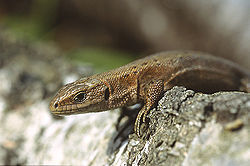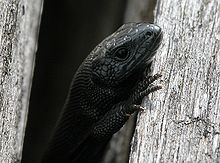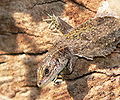- Viviparous lizard
-
Viviparous lizard, common lizard 
Male viviparous lizard Conservation status Scientific classification Kingdom: Animalia Phylum: Chordata Class: Reptilia Order: Squamata Suborder: Lacertilia Family: Lacertidae Genus: Zootoca Species: Z. vivipara Binomial name Zootoca vivipara
(Von Jacquin, 1787)Synonyms Lacerta vivipara Von Jacquin 1787
The viviparous lizard or common lizard (Zootoca vivipara, formerly Lacerta vivipara) is a Eurasian lizard. It lives farther north than any other reptile species, and most populations are viviparous (giving birth to live young), rather than laying eggs as most other lizards do.
Contents
Identification
The length of the body is less than 12 centimetres (5 in) (excluding the tail). The tail is 1.25 to 2 times longer than the body, although it is often partially or wholly lost. The limbs are short, and the head is rather round. Males have more slender bodies than females. The neck and the tail are thick. The collar and other scales seem jagged.
The colour and patterning of this species is remarkably variable. The main colour is typically mid-brown, but it can be also grey, olive brown or black. Females may have dark stripes on their flanks and down the middle of the back. Sometimes females also have light-coloured stripes, or dark and light spots along the sides of the back. Most males and some females have dark spots in their undersides. Males have brightly coloured undersides – typically yellow or orange, but more rarely red. Females have paler, whitish underparts. The throat is white, sometimes blue.
Range
The viviparous lizard is widely distributed throughout Europe and Asia. Its range extends to the north of the Arctic Circle. It ranges from Ireland to Hokkaidō and Sakhalin. It is absent from most of the Mediterranean area, although it occurs in northern Spain, northern Italy, Serbia, Republic of Macedonia and Bulgaria. It is also absent from the area surrounding the Black Sea.
 Melanistic specimen are quite typical for the Großer Feldberg/Taunus mountain in Germany
Melanistic specimen are quite typical for the Großer Feldberg/Taunus mountain in Germany
In the southern parts of its distribution range the species lives at high elevations, occurring as high as 3,000 metres in the Alps. In these areas the viviparous lizard lives in damp places or near water, including meadows, swamps, rice fields, by brooks and in damp forests. In the northern part of the range the species is also found in lowlands, where it occurs in drier environments, including open woodland, meadows, moorland, heathland, fens, dunes, rocks, roadsides, hedgerows and gardens. It lives mainly on the ground, although it may climb onto rocks, logs and low-growing vegetation.
Behaviour
The viviparous lizard feeds on invertebrates, mostly small insects. It shakes larger prey in its jaws before chewing it and swallowing it whole. In early spring, late autumn, and cool summer days it basks in the sun to reach its optimum body temperature, which is about 30°C.
The lizard mates in April or May. Males take females in their jaws before mating – if the female is not interested, she will bite the male fiercely. The offspring develops for approximately three months inside the female.
The name of the species is derived from its ability to give birth to live young, an adaptation to a cool climate – but some southern populations are oviparous (egg-laying). The 3-10 young (or eggs) are usually produced in July. The blackish young measure about 3 cm, and when first born are surrounded by egg membrane, from which they break free after about a day. Males reach sexual maturity at two years old, females at three years old. Individuals from viviparous and oviparous populations may be hybridised, but with significant embryonic malformation (Heulin et al. 1989).
In northern regions viviparous lizards begin hibernation in September or October, underground or in log piles. Hibernation ends about mid-February. Further south the species is active throughout the year.
Gallery
References
- E. N. Arnold, J. A. Burton (1978). A Field Guide to Reptiles and Amphibians of Britain and Europe
- Jiří Čihař (1994). Amphibians and reptiles. Wingston: Magna. ISBN 1-85422-788-2
- ARKive: viviparous lizard
- The Reptile Database – Distribution details, authority information
- IUCN Red List for conservation status
- Heulin, B., Arrayago, M. J., and Bea, A. 1989. Experience d'hybridation entre les souches ovipare et vivipare du lezard Lacerta vivipara. Comp. Rend. Acad. Sci. Series 3 308: 341-346 (cited by The Reptile Database)
- List of reptiles of Italy
Categories:- IUCN Red List least concern species
- Wall lizards
- Reptiles of Europe
- Fauna of Finland
- Fauna of Ireland
- Fauna of the United Kingdom
- Reptiles of Asia
- Reptiles of Japan
- Arctic land animals
- Animals described in 1787
Wikimedia Foundation. 2010.








